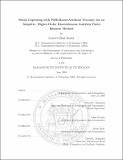Shock capturing with PDE-based artificial viscosity for an adaptive, higher-order discontinuous Galerkin finite element method
Author(s)
Barter, Garrett E. (Garrett Ehud), 1979-
DownloadFull printable version (8.167Mb)
Alternative title
Shock capturing with partial differential equation-based artificial viscosity for an adaptive, higher-order discontinuous Galerkin finite element method
Other Contributors
Massachusetts Institute of Technology. Dept. of Aeronautics and Astronautics.
Advisor
David L. Darmofal.
Terms of use
Metadata
Show full item recordAbstract
The accurate simulation of supersonic and hypersonic flows is well suited to higher-order (p > 1), adaptive computational fluid dynamics (CFD). Since these cases involve flow velocities greater than the speed of sound, an appropriate shock capturing for higher-order, adaptive methods is necessary. Artificial viscosity can be combined with a higher-order discontinuous Galerkin finite element discretization to resolve a shock layer within a single cell. However, when a nonsmooth artificial viscosity model is employed with an otherwise higher-order approximation, element-to-element variations induce oscillations in state gradients and pollute the downstream flow. To alleviate these difficulties, this work proposes a new, higher-order, state based artificial viscosity with an associated governing partial differential equation (PDE). In the governing PDE, the shock sensor acts as a forcing term, driving the artificial viscosity to a non-zero value where it is necessary. The decay rate of the higher-order solution modes and edge-based jumps are both shown to be reliable shock indicators. This new approach leads to a smooth, higher-order representation of the artificial viscosity that evolves in time with the solution. For applications involving the Navier-Stokes equations, an artificial dissipation operator that preserves total enthalpy is introduced. The combination of higher-order, PDE-based artificial viscosity and enthalpy-preserving dissipation operator is shown to overcome the disadvantages of the non-smooth artificial viscosity. The PDE-based artificial viscosity can be used in conjunction with an automated grid adaptation framework that minimizes the error of an output functional. Higher-order solutions are shown to reach strict engineering tolerances with fewer degrees of freedom. (cont.) The benefit in computational efficiency for higher-order solutions is less dramatic in the vicinity of the shock where errors scale with O(h/p). This includes the near-field pressure signals necessary for sonic boom prediction. When applied to heat transfer prediction on unstructured meshes in hypersonic flows, the PDE-based artificial viscosity is less susceptible to errors introduced by poor shock-grid alignment. Surface heating can also drive the output-based grid adaptation framework to arrive at the same heat transfer distribution as a well-designed structured mesh.
Description
Thesis (Ph. D.)--Massachusetts Institute of Technology, Dept. of Aeronautics and Astronautics, 2008. This electronic version was submitted by the student author. The certified thesis is available in the Institute Archives and Special Collections. Includes bibliographical references (p. 135-143).
Date issued
2008Department
Massachusetts Institute of Technology. Department of Aeronautics and AstronauticsPublisher
Massachusetts Institute of Technology
Keywords
Aeronautics and Astronautics.